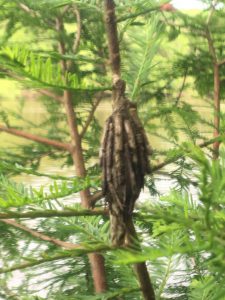
A few months back, a reader sent me a photo of an interesting cocoon he noticed on a cypress tree. He was along the Choctawhatchee River in Washington County, which has some beautiful hardwood swamp areas (and some of the largest old growth cypress trees I’ve ever seen). The cocoon was composed of tiny sticks broken into evenly sized pieces, like a miniature log cabin reformed into a sack.
This interesting object hanging from the cypress was a bagworm (Thyridopteryx ephemeraeformis). The male adult bagworm is a hairy black moth, while the female actually lives out her entire life within the bag. She remains primarily in a caterpillar-like form, with a small mouth, eyes, and no wings. After mating, she is essentially converted into a sac filled with eggs. Neither has a long life, with females living a few weeks and males only a day or two.

During this short life, the female lays 500-1000 eggs inside the case. The eggs will overwinter and hatch the following spring. When larvae hatch, they spin a thread and “balloon” into the wind the same way baby spiders do. Growing young caterpillars find a host plant, then use their silk to form the bag from leaves and small bits of twigs. Surrounded by its new home, only the caterpillar’s head and part of its thorax exit the top of the bag to allow for movement and feeding.
Maturity takes about 4 months, and mating takes place while the male hangs upside down from the female’s bag. Once eggs are produced, the female often dies and mummifies around her eggs.
Bagworms can be commonly found on cedar, cypress, live oak, pine, and Indian hawthorn, along with dozens of other tree/shrub species. They are considered pest insects if found in larger numbers (covering >10% of plant). Handpicking is one of the best ways to control them if you have a major infestation in your home landscape. However, when out in the “wild” they are a really interesting little curiosity to keep an eye out for.
 1
1
